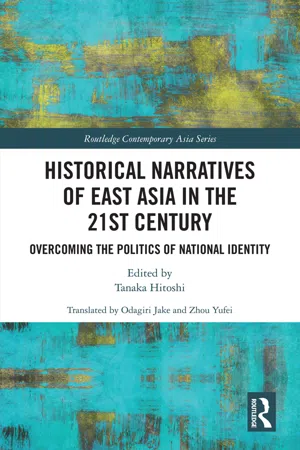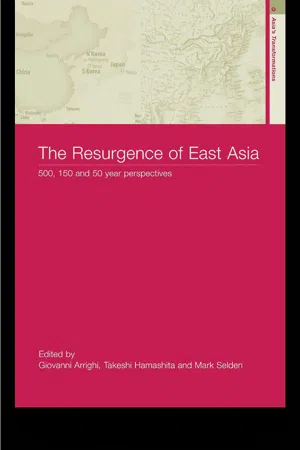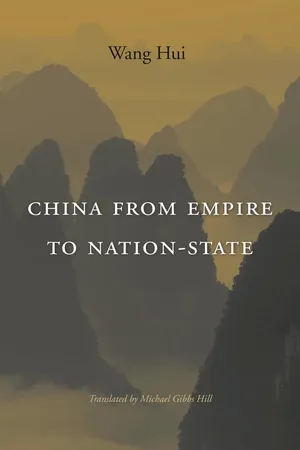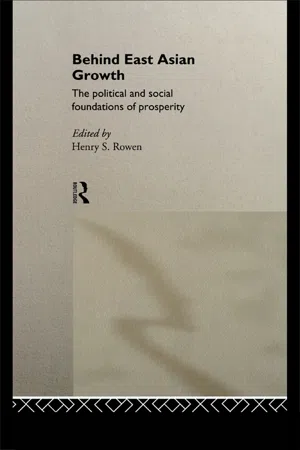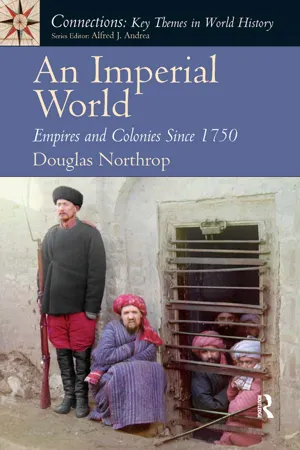History
East Asian Empires
The East Asian Empires refer to the powerful and influential imperial dynasties that ruled over East Asia, including the Chinese, Japanese, and Korean empires. These empires were characterized by strong centralized governments, sophisticated bureaucracies, and significant cultural and technological advancements. They played a crucial role in shaping the history and development of East Asia, leaving a lasting impact on the region.
Written by Perlego with AI-assistance
Related key terms
6 Key excerpts on "East Asian Empires"
- eBook - ePub
Historical Narratives of East Asia in the 21st Century
Overcoming the Politics of National Identity
- Hitoshi Tanaka, Jake Odagiri, Yufei Zhou(Authors)
- 2020(Publication Date)
- Routledge(Publisher)
Although Japan also suffered from being forced to sign unequal treaties and subsequently have its sovereignty partly damaged, the “Todai version” makes no reference to the Western powers’ invasion of Japan. This places the “Todai version” apart from the “Changchun version” and the “Changbi version.” What did the authors intend to demonstrate by shedding light on Japan’s national crisis in the dichotomy between East and West? Maybe they uncovered the Western invasion of Japan in order to veil Japan’s violence toward Asian countries, or perhaps they sought to re-emphasize the historiography of “the country of the Gods” that refrains from invasion and being invaded.3 Empire, the dream of becoming an empire, and the making of empiresIn the previous section, I claimed that modern Japan’s path toward becoming an empire started in 1874. Different to my periodization, the majority of general histories on Japan—as well as the “Todai version” of East Asian history—dates the beginning of Japan’s rise to an empire to its occupation of Taiwan. Is this periodization justified? How would the “Changchun version” depict the Qing Dynasty’s imperial policies that sought to respond to Japan’s rise to power?The two Chinese characters of “Teikoku” (or Diguo 帝国) can be traced back to the translation of the Dutch word “keizerrijk” and the English word “empire” in the Bakumatsu period. In the history of both Europe and Asia, empires have existed in various forms. In pre-modern eras, an empire meant an absolute ruler’s control over a vast territory. After constitutional systems came into being in modern times, regardless of whether an absolute ruler existed, “empire” meant the hierarchical ruling system of modern states over a vast territory including itself and remote areas inhabited by other races. As Eric Hobsbawm has made clear, emperors and empires have existed for a long time, but imperialism is a newly emerged phenomenon. It is new in questing for an empire with modern state as the ruling subject.4 - eBook - ePub
The Resurgence of East Asia
500, 150 and 50 Year Perspectives
- Giovanni Arrighi, Takeshi Hamashita, Mark Selden, Giovanni Arrighi, Takeshi Hamashita, Mark Selden(Authors)
- 2004(Publication Date)
- Routledge(Publisher)
This second temporality is the “long” century that separates us from the “relatively brief but deeply felt eclipse” of the prestige and power of the region in the mid-nineteenth century in the wake of the decline of the Qing and Tokugawa regimes in China and Japan, the defeat of China in the Opium Wars, the subsequent collapse of the Chinese empire, and the colonization of large parts of East Asia. The events that most decisively shaped the region in this “long” century began with the relative decline of East Asia in military and economic terms, the advance of Western power in the region in the form of colonial regimes in its peripheries and the sharp decline in the power of its core states (China and Japan), giving rise to the Meiji Restoration of 1868, Japan’s industrialization and subjugation of substantial parts of East Asia, successive Chinese revolutions from the 1860s through 1911 to 1949 and beyond, the recurrent invasions and wars that set Japan against China throughout the first half of the twentieth century, and Japanese efforts to displace China as the regional hegemon, to reorganize the region with itself at the center, and to drive the Western colonial powers from the region. Once again, however, the events that shaped East Asia in this period can best be understood as the outcome of processes encompassed by an even longer temporality.This longer temporality invites and enables us to seek connections between the present rise of East Asia and the region’s earlier position “in the forefront of world development,” as Rozman put it in the passage quoted above. Substantial literatures pivoting on concepts of incorporation, colonialism, modernization and “response to the West” tend to imply a more or less complete displacement of the East Asian historical heritage of this earlier period. We disagree and see instead processes of hybridization and cross-fertilization accompanying the emergence of Western economic and military power as significant forces in the region from the sixteenth to the eighteenth centuries, and continuing in new ways throughout and subsequent to the era of imperialism and revolution in East Asia. In these processes, elements of the East Asian historical heritage would repeatedly reassert themselves to shape interactions within the region and between the region and the world at large right up to the present.In short, we propose an analysis of the East Asian regional political economy along three distinct temporal dimensions, embedded within one another in Russian doll fashion. The long perspective is defined by the historical heritage of a period spanning the sixteenth to eighteenth centuries in which East Asia remained in the forefront of world development in the spheres of state-making and national economy-making, while interactions and hybridization between the European and East Asian regions intensified. The intermediate perspective begins with the eclipse of East Asian wealth and power in the face of the nineteenth- and twentieth-century challenge of Western imperialism. Even before the end of this period we nonetheless note signs of resurgent power in East Asia, most notably in the formation of the Japanese empire, but also in revolutionary processes in China and elsewhere that would subsequently bear fruit. Finally, the shortest perspective is defined by the region’s economic renaissance following its reorganization during and after the Cold War era. The collective claim of this book is that each of these perspectives has something valuable to offer toward the understanding of the present rise of East Asia and the modern world system and that their combination offers fresh light on the future of regional and global processes. - eBook - ePub
- Hui Wang, Michael Gibbs Hill, Michael Gibbs Hill(Authors)
- 2014(Publication Date)
- Harvard University Press(Publisher)
W. F. Hegel, and Marx, the images of Asia and Europe are built up according to a teleological framework that opposes them to one another both in terms of political forms and economic forms: empire and nation-state, and agrarian economies and industrial or trade-based economies. 14 Within this dualistic framework, the concept of “Asia” possesses the following characteristics: it is ruled by multiethnic empires, which stand in contrast to the early modern European states or monarchies; it is dominated by political despotism, which stands in contrast to early modern European legal and political systems; and it is dependent on nomadic or agrarian modes of production, which are completely different from urban life and trade in Europe. It is only when we begin from this perspective that we can understand the narratives and rhetorical strategies concerning China that were employed by European thinkers of this era. Montesquieu, for example, rejected out of hand some of the relatively positive accounts about Chinese politics, law, customs, and culture that came from missionaries and from discussions in the European Enlightenment (the same accounts that had provided inspiration for positive discussions of China by Voltaire and Leibniz). Instead, Montesquieu used the concepts of “despotism” and “empire” to characterize the entire political culture of China. 15 According to his classic account, the main characteristic of an empire is that the paramount ruler uses military force to monopolize the power to distribute property, thereby wiping out any aristocratic systems that might balance out autocratic rule and suppressing the emergence of separate nation-states. This narrative not only lacks any discussion of individual characteristics of such “Asian empires” as the Ottoman Empire, Mughal Empire, Russian Empire, or Qing dynasty, but also admits no possibility for societies to be produced by interaction or by hybrid relationships - eBook - ePub
Modern East Asia: An Introductory History
An Introductory History
- John Miller(Author)
- 2014(Publication Date)
- Routledge(Publisher)
East Asian kings, like those elsewhere, surrounded themselves with pomp and circumstance and often secluded themselves in magnificent palaces such as Beijing’s Forbidden City that were designed to inspire a sense of awe and mystery. Kings also invoked religious sanctions to buttress their authority, and many were credited with supernatural powers. Those in Muslim lands, who were known as sultans, acted as defenders and propagators of the Islamic faith. Buddhist kings in Burma, Thailand, and Cambodia upheld Buddhism’s teachings and regulated its clergy. Under the variant of Buddhism that prevailed there, they were regarded as figures of exceptional “merit” rather than divinities. But ordinary folk did not make this distinction, seeing them as godlike manifestations of the Buddha who possessed divine powers that ensured the harmony of the cosmos. The Confucian monarchs of China, Korea, and Vietnam performed similar cosmic functions, including controlling the forces of nature and guaranteeing bountiful harvests. But they were also considered indispensable to inculcating morality and proper social behavior on which civilized life depended.Whether as kingdoms or as empires, dynastic states headed by divinely inspired monarchs proved to be an extraordinarily durable form of political organization in the premodern world. In East Asia, many of these states endured for centuries, surviving civil wars, dynastic changes, foreign invasions, economic breakdowns, and ideological challenges. Some eventually succumbed, like the Khmer Empire, mainland Southeast Asia’s preeminent power between the tenth and fourteenth centuries C.E. The roughly contemporaneous Mongol Empire and Srivijayan and Majapahit trading empires, based in Sumatra and Java respectively, were also ephemeral. One common denominator of these relative failures might be the phenomenon of “imperial overstretch,” in which the ambitions of rulers outran the human and material resources available to them, resulting in demoralization and disaffection. The Khmer collapse, for example, was linked with the temple-building mania of kings, which diverted manpower from the maintenance of the lower Mekong irrigation systems on which the livelihood of Cambodian peasants depended, leading to the withdrawal of support for the monarchy.The Chinese Empire stands as East Asia’s and perhaps the world’s most successful dynastic state insofar as it survived for more than two millennia under six major dynasties. Given China’s huge size and diversity, particularly its north-south division, one might expect it to have disintegrated into multiple states. This in fact occurred at times of political disunity that were exploited by nomadic invaders from Inner Asia who set up independent states in the north. Two groups of invaders, the Mongols and the Manchus, even conquered China and created their own dynasties in the thirteenth and seventeenth centuries. Throughout it all, however, the Chinese clung to the ideal of a unitary state under a single all-powerful ruler assisted by mandarin scholar-bureaucrats. One reason for the persistence of this ideal is the fact that the Chinese remained ethnically and culturally homogenous. In contrast to the Roman and other empires, China was never inundated by alien settlers. The steppe nomads were few and their pastoral way of life was not transferable to China’s densely populated agricultural heartland. To govern China, moreover, they had to adopt Chinese ways, with the result that most ended up being absorbed or Sinicized. - eBook - ePub
Behind East Asian Growth
The Political and Social Foundations of Prosperity
- Henry S. Rowen(Author)
- 2002(Publication Date)
- Routledge(Publisher)
1 The political and social foundations of the rise of East Asia: an overviewHenry S.Rowen
This book addresses this question: why have so many East Asian countries had such remarkably strong and sustained economic growth? The conventional—and clearly correct—answer is that they adopted unusually good policies. But why did they do so? Their record of development is so exceptional, not only in comparison to other developing regions but in world history, that it has recently attracted the attention of scholars from many fields. Because no single discipline has provided a persuasive explanation, this book draws on several in an effort to produce a more convincing explanation than has heretofore been advanced.The current interest in what can be called the new Asian exceptionalism is juxtaposed against a long-standing puzzle about China: why—when it advanced to the threshold of a systematic experimental investigation of nature and created the world’s earliest mechanized industry from the tenth to the fourteenth century—was it unable to sustain that progress?1 Although Japan was the first non-European-culture country to break out of the near universal pattern of slow development in the mid-nineteenth century, almost another 100 years passed before other East Asian nations followed suit. Despite this lag they were still ahead of the rest of the developing world.These countries’ economic policies have been consistently better than those in other developing regions. Their strategies have varied, with some governments strongly shaping their industrial structures (notably South Korea) and others being hands-off (notably Hong Kong); nonetheless, the area of consensus among experts on the merits of these strategies is much greater than that of dissonance. - eBook - ePub
An Imperial World
Empires and Colonies Since 1750
- Douglas Northrop(Author)
- 2016(Publication Date)
- Routledge(Publisher)
Once enunciated, it suggested the importance of racial/cultural affinity and the central-ity of an “Asian” frame of reference. As a justification for empire it thus implied a relatively privileged position, at least in the long term, for Chinese, Korean, and Taiwanese subjects. Certainly this could not happen while Koreans continued to rebel; but perhaps for this reason Manchukuo remained nominally sovereign and separate from Japan, in a strange (and expensive) arrangement as a puppet state. 14 Such oddities help explain another curious feature of the Japanese empire, its economic structure. As already noted, Japan exploited colonies for their resources, as other empires around the world also did. Following its division into “outer” and “inner” zones, though, Japan created institutional arrangements that privileged its closer Asian “cousins.” A “Greater East Asia Co-Prosperity Sphere” called for heavy industry not just in the metropole, but throughout the core areas of the inner empire—Korea, Taiwan, Manchukuo, and northern China, as well as mainland Japan. Manchuria, for instance, saw new factories built to produce iron and steel, automobiles, and advanced chemicals. In the words of Foreign Minister Arita Hachiro, geography and economy should join culture and race: “The countries of East Asia and the regions of the South Seas are geographically close, [and] historically, racially, and economically very closely related to each other. They are destined to cooperate and minister to one another’s needs for their common well-being and prosperity, and to promote peace and progress in their regions.” 15 Japanese power thus presented itself as helping Asia—portraying military growth as a benevolent expansion that would assist its neighbors in resisting other marauding invaders, namely from the West (see Figure 4.3)
Index pages curate the most relevant extracts from our library of academic textbooks. They’ve been created using an in-house natural language model (NLM), each adding context and meaning to key research topics.
